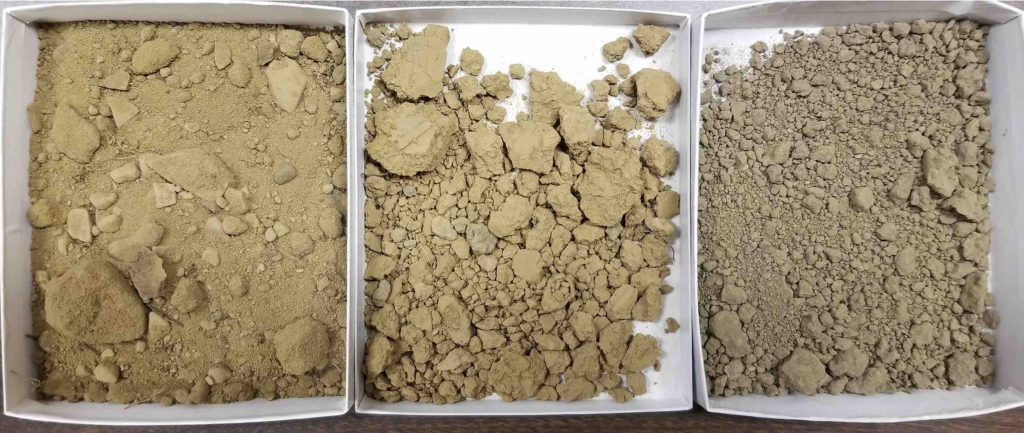
This is a post outlining some of the work we did in Wooster’s class in Geomorphology. One of the early labs was Browns Lake Bog and the Soil Catena.

The landforms in the area are spectacular – here is a kame, a photo taken as we ventured down into the bog.

The group shares a light moment before the 20+ species of mosquitos descended on them in the forest.

The soils from the top of the kame to the base varied more than the group predicted.

We also sampled soils just east of the campus golf course.

Nick and Jerry in the soil pit measuring magnetic susceptibility as Des records the data.

The C-horizon on the left is a sandy, silt gravel – the B-horizon in the middle is blocky loam and the A is a more brown silty material.

The team coring an old growth (300+ year) tree growing on top of the soil site. The landform is a kame terrace that has likely been weathering in place for the last 14,000 years with additional windblown silt being added (or removed) from time to time during the Holocene.

At Zollinger’s Sand and Gravel – posing at the base of the section which is Mississippian bedrock. A big thank you to the Zollinger family for allowing us to work here and for showing us around.

This side of the pit is still being mined, whereas other portions serve as land fill. We learned that lodgement till can be fractured and that it also can be mined and serve as a landfill liner.

On the way back to campus we stopped at the artesian spring near the Wayne County Airport.

Of course not class would be complete without a trip to Spangler. Here the group is standing inf ront of one of the unconformities, which is composed of a lodgement till overlain by fluvial and alluvial sediments. The interface of these units is where the geochmistry is just right to generate concretions.

The increasingly greater precipitation events are moving larger and large block of bedrock. Here the Wooster Shale is being excavated by 1-2 inch storm events. Our hypothesis is that erosion rates over the last few decades are unprecedented perhaps over much of the Holocene.
 Big blocks are moved routinely – they are plucked out by the stream along planes of weakness (fractures). Note how the shales break up readily. A block like those above will be mud again in a matter of months. Swelling clays and strong wetting and drying does the job.
Big blocks are moved routinely – they are plucked out by the stream along planes of weakness (fractures). Note how the shales break up readily. A block like those above will be mud again in a matter of months. Swelling clays and strong wetting and drying does the job.

Here is a series of debris flows (gray sediment) – we obtained two radiocarbon ages that show intervals of mass movements about 2.5 ka, these are dates on charcoal that may be from fires used in land management by native Americans at the time.
 Stream gaging along Apple Creek. The group gets some hand-on experience with the equipment and puzzles over the various facies of a fining upward fluvial sequence.
Stream gaging along Apple Creek. The group gets some hand-on experience with the equipment and puzzles over the various facies of a fining upward fluvial sequence.
 Nick and Tyrell take turns in the deep end.
Nick and Tyrell take turns in the deep end.

Jack giving the group the rundown on riparian vegetation.

As it turn out the floods here get pretty high, this tree was scarred when a log (or a washing machine) floated by during a high flow.

The class at Fern Valley standing in front of Columbia Gas’ well-head for the natural gas storage field. The group was investigating the possibility that mass movements at the site might impact the infrastructure and pipelines in the area.

The slump block at Fern Valley is clearly seen from above. It is a series of glacial ice-contact stratified drift deposits overlain by a thick (40+ foot) layer of varved lacustrine clays. What you see in the woods is a major 2-3 meter scarp (normal fault) as the block descends into the valley.

The class at Fern Valley. A big thank you Nick Wiesenberg for arranging the logistic for the trips. We would also like to thank bus drivers Mark Livengood and Fred Potter for getting us to and from the sites safely. A special thanks to Fred who will be retiring soon – we appreciate your expertise and knowledge of the Wooster area.



Excellent, colorful, inspiring post, Dr. Wiles! I wish I could take this course. Your students had wonderful field trips — experiential learning at its best.